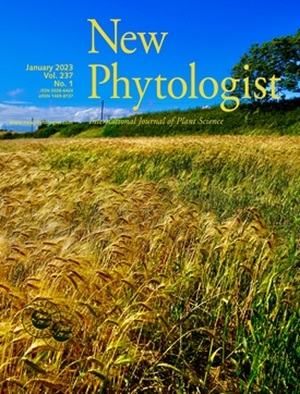Elevated CO2 mediates ectomycorrhizal fungi species-specific decreases of native soil carbon and causes negative priming under low nutrients.
IF 8.3
1区 生物学
Q1 PLANT SCIENCES
引用次数: 0
Abstract
Ectomycorrhizal fungi (ECM) can influence soil carbon (C) accrual and loss. The mechanisms and environmental controls of this balance are unclear, and direct evidence is needed. We assessed the influence of atmospheric CO2 and inorganic nitrogen (N) on the impact of two ECM fungi on the cycling of native and new soil C. We inoculated Eucalyptus under continuous C isotopic labeling with two species of Pisolithus and manipulated inorganic N (high/low) and CO2 (ambient/elevated, aCO2/eCO2). We differentiated plant-derived C and native soil-C in soil, dissolved-C, microbial-C, and CO2. Under eCO2, Pisolithus albus increased plant-derived dissolved organic C compared to the uninoculated control and reduced soil-derived C compared to both the uninoculated control and Pisolithus microcarpus, consistent with the facilitation of soil C decay. While ECM effects were not dependent on N, eCO2 reduced soil-derived C loss under low N, demonstrating suppression of decomposition (negative C priming) under low nutrients. These findings highlight that closely related ECM fungal species have contrasting capacities to impact different pools of soil C. For some ECM species, eCO2 may favor soil C decay. Our findings call for caution in generalizing the role of ECM fungi on soil C and of N availability on eCO2 impacts.二氧化碳的升高介导了外生菌根真菌物种特异性的原生土壤碳的减少,并在低营养条件下引起负启动。
外生菌根真菌(ECM)影响土壤碳(C)的积累和损失。这种平衡的机制和环境控制尚不清楚,需要直接的证据。我们评估了大气CO2和无机氮(N)对两种ECM真菌对原生土壤和新土壤C循环的影响。在连续的C同位素标记下,用两种Pisolithus接种桉树,并控制无机N(高/低)和CO2(环境/升高,aCO2/eCO2)。我们在土壤、溶解碳、微生物碳和二氧化碳中区分了植物源碳和原生土壤碳。在eCO2条件下,白螺比未接种对照增加了植物源可溶性有机碳,比未接种对照和微果螺减少了土壤源性有机碳,这与促进土壤C衰变的作用一致。虽然ECM效应不依赖于N,但eCO2在低N条件下减少了土壤来源的C损失,表明在低营养条件下抑制了分解(负C启动)。这些发现表明,密切相关的ECM真菌物种对不同土壤C库的影响能力存在差异。对于一些ECM物种来说,eCO2可能有利于土壤C的腐烂。我们的研究结果呼吁在推广ECM真菌对土壤C和N有效性对eCO2影响的作用时要谨慎。
本文章由计算机程序翻译,如有差异,请以英文原文为准。
求助全文
约1分钟内获得全文
求助全文
来源期刊

New Phytologist
生物-植物科学
自引率
5.30%
发文量
728
期刊介绍:
New Phytologist is an international electronic journal published 24 times a year. It is owned by the New Phytologist Foundation, a non-profit-making charitable organization dedicated to promoting plant science. The journal publishes excellent, novel, rigorous, and timely research and scholarship in plant science and its applications. The articles cover topics in five sections: Physiology & Development, Environment, Interaction, Evolution, and Transformative Plant Biotechnology. These sections encompass intracellular processes, global environmental change, and encourage cross-disciplinary approaches. The journal recognizes the use of techniques from molecular and cell biology, functional genomics, modeling, and system-based approaches in plant science. Abstracting and Indexing Information for New Phytologist includes Academic Search, AgBiotech News & Information, Agroforestry Abstracts, Biochemistry & Biophysics Citation Index, Botanical Pesticides, CAB Abstracts®, Environment Index, Global Health, and Plant Breeding Abstracts, and others.
 求助内容:
求助内容: 应助结果提醒方式:
应助结果提醒方式:


